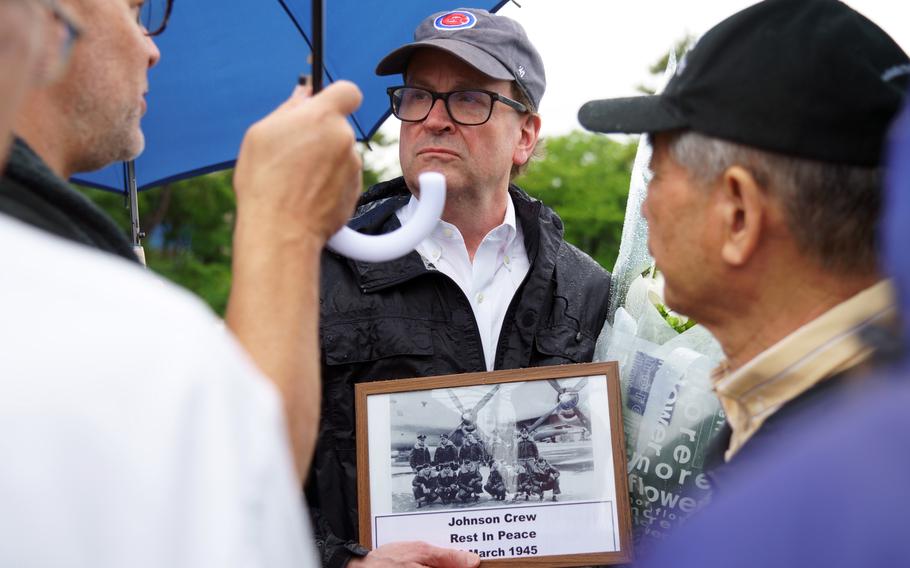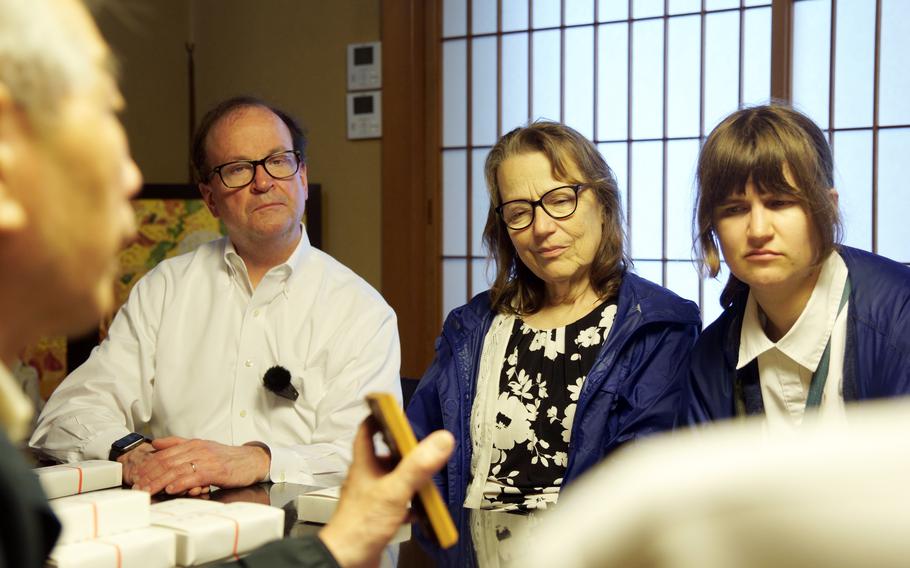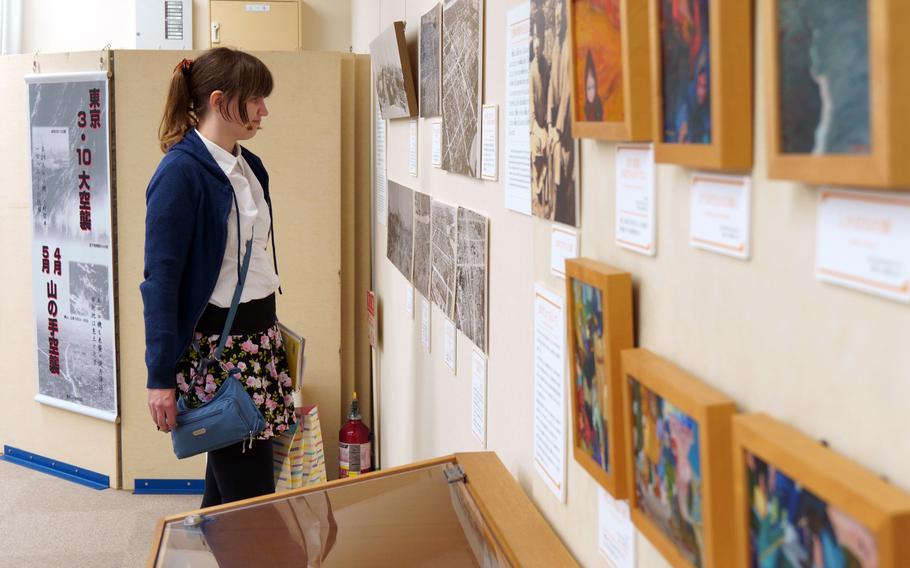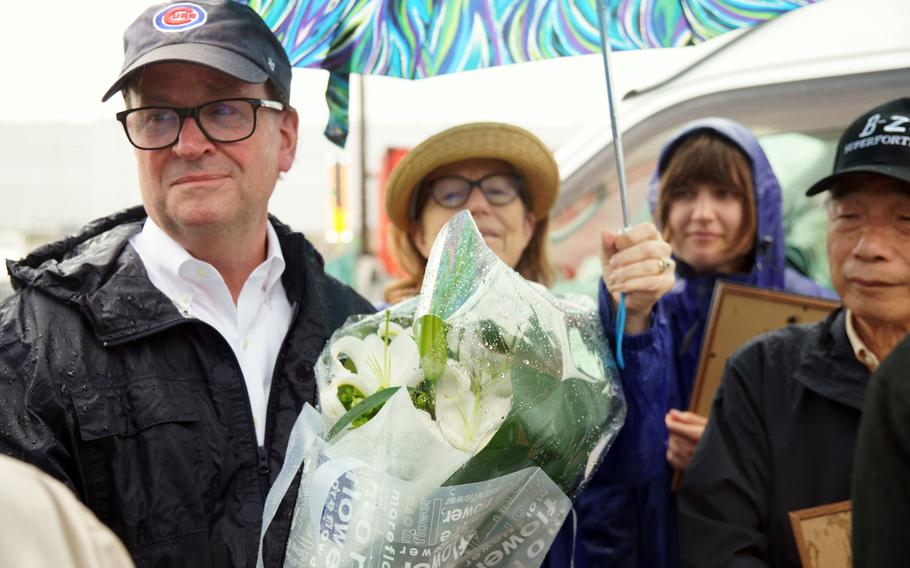TOKYO — The family of a lost American World War II aviator tossed lily petals into Tokyo Bay on Friday near the spot where his B-29 Superfortress bomber crashed 78 years ago.
Bill O’Connor, 70, his wife, Pamela, and their daughter, Suzanne, traveled to the Japanese capital from their home in Richmond, Va., to learn more about the fate of Bill’s uncle, U.S. Army Air Forces 2nd Lt. Edward O’Connor.
The young officer was the navigator on one of more than 300 U.S. aircraft that participated in the firebombing of Tokyo on March 10, 1945.
His plane — assigned to the 43rd Bombardment Squadron and among only a few that went down over the city during the raid — crashed near the shoreline in Tokyo’s Sunamachi district. The site, close to a former Japanese naval shipyard, was the target of some of the heaviest bombing.
Today, the spot where the Superfortress crashed and 11 crew members are believed to have perished, is a quiet marina where pleasure boats moor in placid waters.

Bill O’Connor, nephew of U.S. Army Air Forces 2nd Lt. Edward O'Connor, holds a photo of a U.S. B-29 Superfortress crew while visiting Tokyo Bay on June 9, 2023. His uncle died when the bomber went down in the bay on March 10, 1945. (Akifumi Ishikawa/Stars and Stripes)
Among a few locals who visited the marina with the family on Friday was Tatsuya Fuse. Born and raised in Sunamachi, he was a schoolboy and evacuated to Chiba prefecture during the war.
At the marina he sang “Umi Yukaba,” an old song that Fuse said reminds him of war’s tragedy.
"I was overwhelmed with emotion when thinking about the family’s feelings," he said of his decision to sing.
Growing up in Chicago, Bill O’Connor heard stories about his uncle, who was revered by family and friends.
“Ed had the alpha reputation,” the retired drapery manufacturer recalled as he stood near the crash site. “The best athlete, best student. He was my dad’s hero.”

Bill O’Connor, his wife, Pamela, and their daughter, Suzanne, visit Jihoin, a Buddhist temple in Tokyo, June 9, 2023. The family traveled to the Japanese capital from their home in Richmond, Va., to learn more about the fate of Bill’s uncle, U.S. Army Air Forces 2nd Lt. Edward O’Connor. (Akifumi Ishikawa/Stars and Strip)
‘Tiny Tim’
The Superfortress crew named their aircraft “Tiny Tim” after Edward O’Connor’s young son, Tim, who now lives in Copenhagen, Denmark, Bill O’Connor said.
From the crash site, the family traveled to a nearby temple, Jihoin, where locals had buried the fallen bomber crew. After the war, U.S. forces transferred their remains to Yokohama and later Hawaii and the Philippines, according to Japanese B-29 researcher Isao Arai.
Arai was a boy when he saw a B-29 crash in Shizuoka prefecture during the war. He wore a Superfortress ballcap while accompanying the O’Connor family on Friday.
Edward O’Connor’s body has never been identified, according to Bill O’Connor, who said he provided a DNA sample a few years ago at the request of a group seeking to identify lost airmen.

Suzanne O’Connor visits the Center of the Tokyo Raids and War Damage in Tokyo, June 9, 2023. Her great-uncle, Army 2nd Lt. Edward O’Connor, died when his B-29 Superfortress crashed into Tokyo Bay on March 10, 1945. (Akifumi Ishikawa/Stars and Stripes)
The Defense POW/MIA Accounting Agency lists Edward O’Connor as “unaccounted for” and states, on its website, that he is memorialized on the Courts of the Missing at the National Memorial Cemetery of the Pacific in Honolulu.
At the temple on Friday, chief priest Kenei Itabashi prayed for the deceased aviators and called out their names while striking a large bell.
“Reading the names of the crew was the most moving part,” Bill O’Connor said afterwards.
‘Deeply thoughtful’
The O’Connors stopped next at the Center of the Tokyo Raids and War Damage in the city’s Koto district. The center preserves the memory of the raid that the fallen bomber crew participated in, which killed an estimated 100,000 civilians, according to the center.
The center’s collection includes photographs of the bombing’s aftermath that show piles of burned bodies, along with art produced by survivors showing burning buildings and people.

Bill O’Connor, nephew of U.S. Army Air Forces 2nd Lt. Edward O'Connor, holds flowers for a U.S. B-29 Superfortress crew while visiting Tokyo Bay on June 9, 2023. His uncle died when the bomber went down in the bay on March 10, 1945. (Akifumi Ishikawa/Stars and Stripes)
On display, there’s a replica of an M69 oil incendiary bomb of the sort that was dropped on Tokyo.
The family’s last stop was Juganji, a Buddhist temple near the Tokyo Skytree tower, where a propeller from a crashed B-29 is displayed.
“It’s not that if you don’t learn history, you will repeat the mistakes,” Bill O’Connor said after seeing the 8-foot-long propeller. “Today, it’s that if you don’t learn history, we will believe anything anybody tells us.”
The family appears to be the first relatives of the Tiny Tim crew to visit Japan, Arai said.
"No one had come to the crash site, although there were many [other family members of the bomber crew] who I spoke with," he said. "I've never met people as deeply thoughtful of their family.”